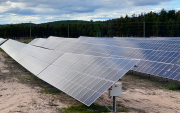In case you missed it, 93% of Canadians now live in provinces and territories that have implemented, or are in the process of implementing, carbon pricing. The most recent step forward occurred this week in Nova Scotia. Amid the excitement around Canada’s accelerated coal phase-out, Premier Stephen McNeil announced that his government will implement a cap-and-trade system in 2018. This commitment puts another province in line with the federal government’s plan to price carbon pollution.
Nova Scotia’s move builds on two other recent examples of carbon pricing progress. While it hasn’t decided on the exact approach, Manitoba has confirmed that it plans to implement a “made-in-Manitoba” approach to carbon pricing. The second example is the Yukon: the territory’s November 7 election saw Sandy Silver and the Yukon Liberals win a majority. They bring a very different perspective to government than outgoing premier Darrell Pasloski’s negative take on carbon pricing.
The new Yukon government intends to allow the federal government to implement its carbon price ($10 per tonne in 2018, rising by $10 per year to $50 per tonne in 2022), which is one of the options put forth by Prime Minister Justin Trudeau. The territory plans to focus its efforts on implementing its own climate plan and ensuring that carbon pricing revenue collected in the Yukon is returned to the Yukon government and then rebated to Yukoners.
Manitoba, Nova Scotia, and the Yukon account for 6% of Canada’s population and 5% of the country’s carbon pollution. While those figures are relatively small, they’re important for at least two reasons. First, it’s beneficial to have smaller provinces and territories implementing carbon pricing, because their challenges and solutions will likely differ in some aspects from the experiences in British Columbia, Alberta, Ontario, and Québec. Similarly, having premiers from the North and Atlantic Canada sign on to the national plan is important politically, because all regions in the country now have a positive stake in carbon pricing.

Nova Scotia’s commitment to cap-and-trade is also a good reminder that carbon pricing is more than a yes/no conversation and that the details do matter. Important details are still to be determined, including what the cap for carbon pollution will be in 2018 or how it will decline over time. The degree to which the government sets the cap below current projections will be an important factor in Nova Scotia’s ability to build on the good progress that the province has made on reducing carbon pollution (particularly from the electricity sector).
The good news is that there’s time for Nova Scotia to figure out those details and hopefully get them right. For the 7% of Canadians living in a province or territory that hasn’t figured out how it is going to price carbon pollution and how it is going to use the revenue, now is the time to encourage their government to get moving. They should be reassured by the fact that provinces and territories representing 93% of Canada’s population — from all regions and economic bases — are already heading in that direction.
This article appeared in the Whitehorse Daily Star on November 29, 2016.








